HALF PRICE SALE ON EVERYTHING ENDS AT MIDNIGHT TONIGHT
NEW SEASON BARE ROOTS AT 50% OFF LAST SEASONS PRICES – ENDS 31 JULY
GET AN EXTRA 10% OFF ALL SALE PRICES WITH CODE FLASH 10 – TODAY ONLY!
Menu
HALF PRICE SALE ON EVERYTHING ENDS AT MIDNIGHT TONIGHT
NEW SEASON BARE ROOTS AT 50% OFF LAST SEASONS PRICES – ENDS 31 JULY
GET AN EXTRA 10% OFF ALL SALE PRICES WITH CODE FLASH 10 – TODAY ONLY!
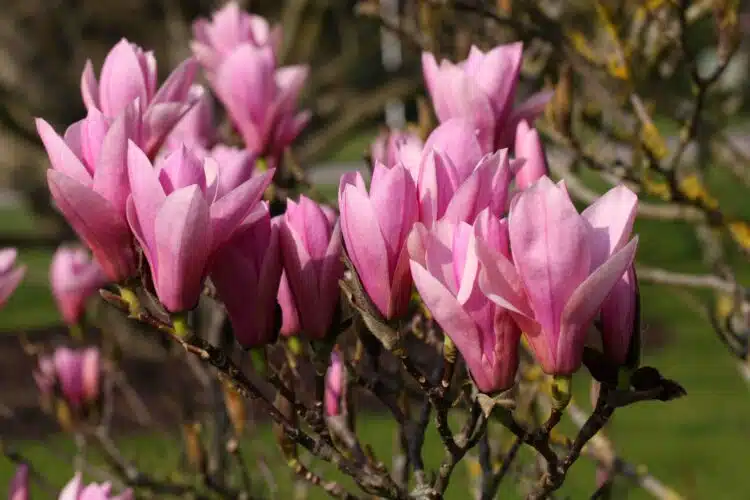 https://www.hopesgrovenurseries.co.uk/wp-content/uploads/2024/02/heaven-scent-al-750x500.jpg
https://www.hopesgrovenurseries.co.uk/wp-content/uploads/2024/02/heaven-scent-al-750x500.jpg
I’ve been writing for almost thirty years now and, should you be fed up with my literary efforts, you should blame the Great Storm of October 1987. The first I knew about it, was an early morning telephone call from my mother, who lived near Kew Gardens. The wind had flattened all the trees in her street and gusts of 115mph had been recorded during the early hours. Kew Gardens was ravaged. Their website tells us that “a staggering 700 trees were lost within just a few violent hours. Many were historic and centuries-old, leaving staff heartbroken.” Damage at Wakehurst Place was even more severe. They lost 20,000 trees and it completely transformed their landscape.
Many famous gardens in the south east saw similar devastation, including High Beeches Garden in West Sussex. This garden was planted up by Sir Robert Loder in l846 and it had some wonderful heritage magnolias. One of the oldest, Magnolia sargentiana var. robusta, was reputedly grown from seeds originally collected by Ernest ‘Chinese’ Wilson in the early 20th century. After the storm, this historic magnolia lay prone on the ground, but the garden team propped it back up, more in hope than certainty. The tree survived, but didn’t flower until ten years later. It was completely smothered in flower and The Daily Telegraph had a sensational picture and they needed a story by lunch time. Their tried and tested writers, like Stephen Lacy, could not be located that morning. They could only find me to write 1000 words on the renaissance of High Beech’s magnolia by midday, so I set to there and then. That magnificent magnolia set my writing career on the right path!
It wasn’t my first encounter, for I have had a love affair with magnolias since childhood. I used to make a weekly journey from Greenford to Ealing Broadway on the 65 Routemaster bus. I’d charge upstairs and try to get the front seat. And I was a nippy child, so I normally did. The whole area was full of Edwardian villas and their front gardens almost always had a tall magnolia. I used to ogle the huge buds and sumptuous satin flowers from my seat, secretly hoping the ride would last forever, or that someone would ring the bell and stop the bus so that I could catch the scent.
The magnolia that captured my heart was a hybrid named M. x soulangeana, the most commonly grown magnolia in this country and in North America. It has tulip-shaped, pale-pink flowers, held on bare branches, in early spring. It was raised by a French botanist named Étienne Soulange-Bodin in 1828. The parents were M. denudata, a white magnolia known as the Chinese Yulang or Lily Tree. The highly fragrant flowers are cup-shaped this was the first Asian magnolia to arrive in Europe, in 1789.Trees were pot-grown in China and forced into precocious flower for Emperor.
Soulange-Bodin crossed this scented white magnolia with M. liliiflora, another Chinese magnolia introduced into Europe in 1790. The slightly later, more-slender flowers, rather tulip-like in shape, are warm-white colour-washed in pink-purple. These days we grow a darker form named ‘Nigra’, for its purple-pink flowers, but this wasn’t introduced from Japan until 1861.
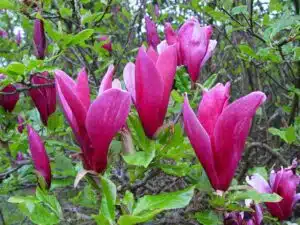
Étienne Soulange-Bodin used the two Asian magnolias in cultivation at the time and, luckily for him, it was embraced by gardeners because it flowered when young. You didn’t have to wait for 20 years, for the first flowers to unfurl. The magnolia per sae is one of our most ancient plants and fossils have been found from the Tertiary Period, between 2 – 65 million years ago. They were around long before the bee, so these luxurious flowers were beetle pollinated.
They thrived in the days when the earth consisted of one single landmass. Over time that single landmass drifted apart and magnolias, like so many of our garden plants, found themselves with one foot in Asia and one in North America. The path of evolution took them along separate routes until the climate changed. Widespread glaciation killed most magnolias off, but they survived in parts of China, Japan, Korea and eastern North America. There are 300 species of this flamboyant plant in the wild, but the most exciting ones are definitely Asian. These have flowers that could be straight out of a French Impressionist painting, all swirl and brush strokes.
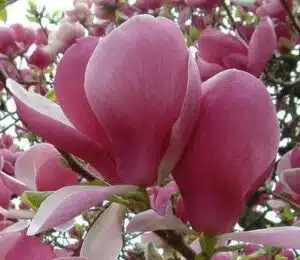
M. x soulangeana needs careful siting, because the early flowers can catch the frost. This causes them to brown overnight and nothing is sadder than a frosted magnolia. They need shelter and this is why they thrived in those suburban Ealing gardens, among the Edwardian villas. The best form and the easiest to grow is ‘Rustica Rubra’, named for its rosy pink flowers. It’s a seedling of ‘Lennei’, an Italian clone, found in a Lombardy garden before 1850. The enormous cream goblets have darker backs, so there’s a touch of the Raspberry Mivvi about this one, if you can remember this ice-cream filled lollies! Both are small enough for most gardens and both flower when young.
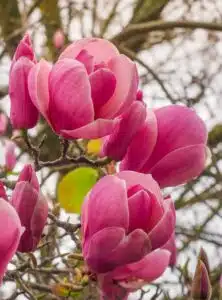
There is a less frost-prone early magnolia, with gappy petals and star-shaped flowers, called M. stellata. The gap between the petals allows cold any air to escape so the flowers are rarely browned by frost. Better still, it’s slow growing, so you won’t need a ladder, or the upper storey of a Routemaster bus, to appreciate the flowers.
M.stellata comes from a small area of Japan in the western Tokai district and it was introduced in 1862, but it has been grown in Japanese gardens for centuries. ‘Rosea’ has pinker flowers than the blush-white M. stellata, but both get smothered in flower in spring. They are wider than taller, so their shrub-like presence can be easily accommodated, even in small spaces.
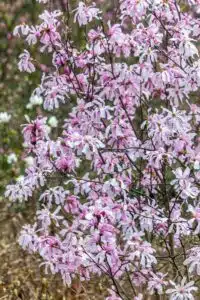
The dark flowers of M. liliifora ‘Nigra’ have been used in magnolia breeding for over a hundred years, because the deep-purple backs are glorious. One of the best hybrids is ‘Heaven Scent’, named for the exquisitely fragrant lavender-pink flowers and these really are like lily-flowered tulips. There’s also a distinctive pink midrib down each petal. This is one of the Californian Gresham hybrids, raised circa 1955, this time between M. veitchii and M. liliifora ‘Nigra’. ‘Heaven Scent’ flowers reliably and is widely grown – always an indicator of a good doer.
In the mid-1960s the National Arboretum in Washington began to hybridise more-compact magnolias. Pollen was taken from Magnolia stellata and transferred to M. liliiflora ‘Nigra’. They selected eight hybrids and gave them girls names, so these hybrids are always referred to as The Eight Little Girls. All of them are multi-stemmed and either rounded or conical in shape.
They flower in May, so are rarely troubled by spring frost, and the fragrant flowers are upright. ‘Betty’ only reaches 15 feet in height, or 5m, after fifty years, so it’s perfect for the smaller modern garden. There are between 12 and 19 tepals per flower and these have red-purple backs and paler insides. The flowers look full. ‘Susan’ has the darkest flowers of all and the narrow petals, which emerge from sickle-shaped buds, splay outwards as the flower matures, displaying the centre of the flower.

Magnolias are superb flowering plants, although they do need careful placing. Avoid frost pockets and windy positions. The ground must be well-drained, or sloping, and they are not generally pruned. They are also surface rooted, so take care when weeding underneath them. The hybrids tend to be smaller in stature and they flower prolifically when young. They also have hybrid vigour.
If you want to see huge hundred-year-old magnolias head towards Cornwall and Devon in April. The National Collection is held at Caerhays Castle and is part of a network of 630 collections held on 450 sites safeguarding around 70,000 species and cultivars. Well over half the magnolia species in existence in the wild are classified as being endangered and the purpose of national collections is to preserve as many species and cultivars of magnolias as possible.
The National Trust’s Bodnant Garden, in North Wales, is another great place to see magnolias. It’s possible to gaze over the steep wooded valley of the River Conwy, across a sea of magnolia flowers, from Bodnant’s formal garden.
Many of our customers buy topiary plants (and hedging plants) to grow in containers, one frequently asked question is how large does the pot that I plant them into need to be?
Expert horticultural advice on the merits and pitfalls of planting bare root yews, and how to get the best from them.
Pleached trees are a garden-design favourite, because they provide an instant leafy screen that looks stylish as soon as it’s planted. They offer privacy for you and they help to muffle noise and that’s becoming more important in our busy world. They provide a living screen that’s far more eco-friendly than a stark wooden fence…